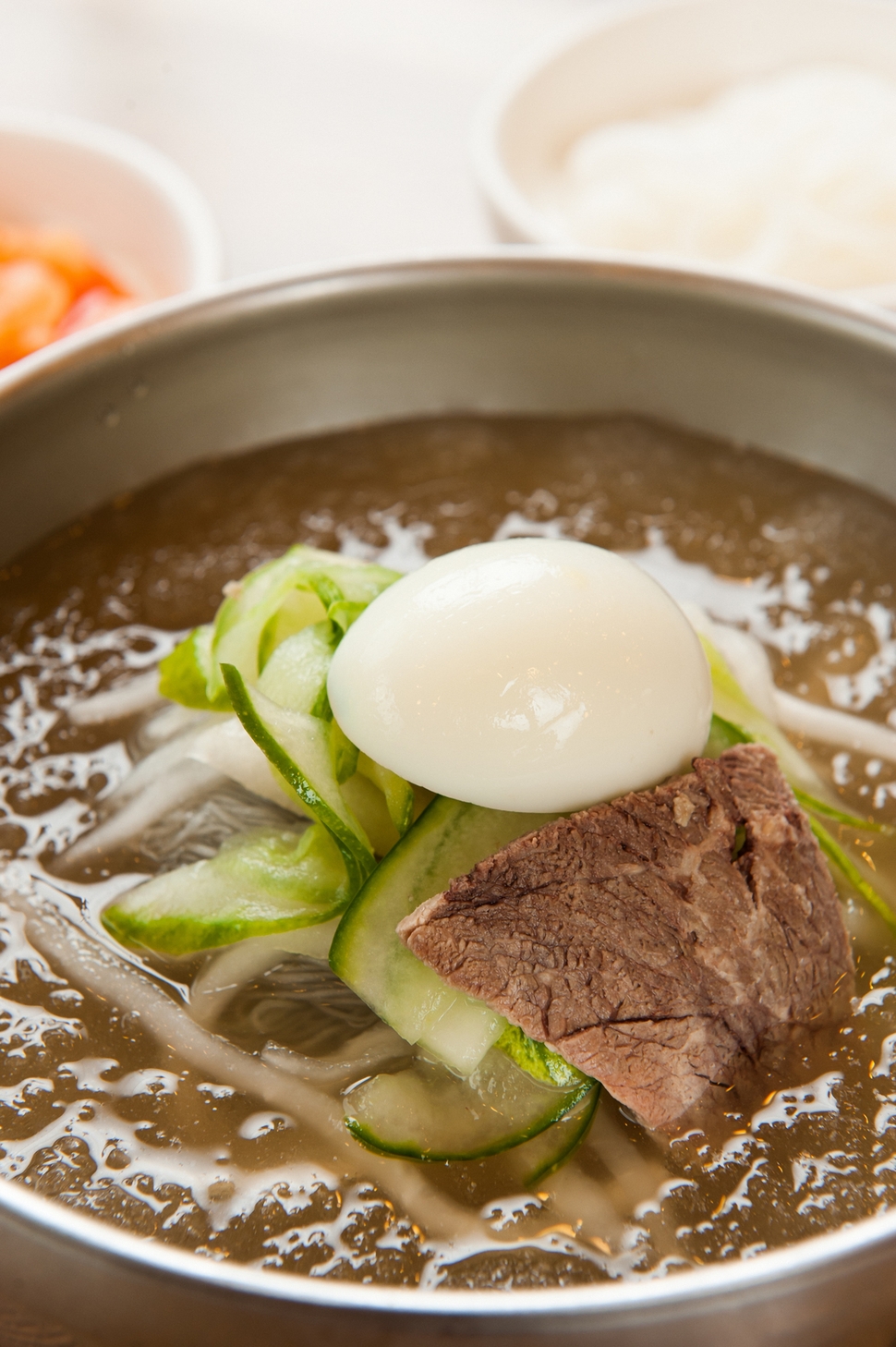[Jul] Either cold or hot – popular Korean dishes help deal with sweltering summers
Date Jul 24, 2022
 A bowl of naengmyeon or cold noodles / Courtesy of gettyimagesbank
A bowl of naengmyeon or cold noodles / Courtesy of gettyimagesbank
It is natural to crave cold food or drinks when the weather gets scorching hot. Koreans do so too. But what is unique is that they also seek “boiling hot” foods, because they believe in the old saying, “iyeol chiyeol” (fight heat with heat).
Cold staples
Apart from salads and some soups, many people in the West and other countries may be unfamiliar with the concept of willingly eating cold food as part of a main meal, but Korea has many cold dishes, usually involving noodles.
Naengmyeon (literally “cold noodles”) is the cold dish staple.
Naengmyeon noodles are made from buckwheat, but the ratios of starch and flour used in the recipes vary by region. The chilled broth is usually made of beef, but regions of North Korea reportedly prefer broth from pheasant meat. The soup from dongchimi (radish kimchi) is also used, alone or mixed with broth.
Garnishes include slices of radishes, cucumbers and the meat used for the broth as well as half of a hardboiled egg.
Before the invention of the refrigerator, naengmyeon was largely enjoyed by people in the colder regions of the Peninsula since it was easier to chill the broth or obtain ice up north. Even today, the two most popular types of naengmyeon in South Korea use recipes associated with the North Korean cities of Pyeongyang and Hamheung.
Pyeongyang naengmyeon noodles are soft and easy to cut because they contain a lot of buckwheat. Starch from regular or sweet potatoes makes the noodles associated with Hamheung relatively thinner and tougher. Hamheung naengmyeon is also often served without broth but with a spicy sauce instead.
Another cold noodle dish is kong-guksu (noodles in chilled soybean soup).
The noodles are made of wheat flour, and the viscosity of the soup is between soybean puree and soy milk. The noodles in the chilled soup are often served with kimchi, especially young radish kimchi called yeolmu kimchi that is also a summer treat.
Korea has not only cold main dishes, but also cold desserts, and bingsu (shaved ice) is one of them. Traditional bingsu was topped with dan-pat (sweet red bean paste) and tteok (rice cake), but in the recent decade, eateries specializing in bingsu have popped up, offering a variety of toppings, from ice cream, chopped fruit and macaroons to a chunk of tiramisu and a whole melon.
 Samgyetang (chicken ginseng soup) served in an earthen pot / Courtesy of gettyimagesbank
Samgyetang (chicken ginseng soup) served in an earthen pot / Courtesy of gettyimagesbank
Hot staples
Korea’s traditional hot dishes for summer were eaten on sambok (the three dog days of summer, those calculated to be the hottest based on the 10 gan (heavenly stems) and 12 ji (earthly branches). They are mainly designed to help people weather the heat by eating food thought to boost stamina.
Samgyetang (chicken ginseng soup) is the most famous and widely consumed dog-day staple today. A chicken is stuffed with glutinous rice, ginseng, garlic and jujubes, and some medicinal herbs are boiled together in the water along with the chicken.
After hours of cooking, the whole chicken is served in an earthen pot, with the soup still boiling. Expect to sweat and possibly burn your tongue while eating samgyetang, but it’s worth it because the chicken meat and ginseng are as delicious as they are nutritious.
For the same reason, chueotang (loach soup) is another widely sought-after hot dish in the summer. Chueotang comes in two varieties: one with the loaches (small freshwater fish) all ground up to make a thick soup or one with them served whole. These days almost all restaurants serve the first option.
The fish is boiled together with radish leaves, and the soup is usually seasoned with perilla seed powder. Savory fried loaches are often served as side dishes with chueotang at many restaurants.
**If you have any questions about this article, feel free to contact us at kocis@korea.kr.**

The Ministry of Culture, Sports and Tourism's "Korea Here & Now" work can be used under the condition of "Public Nuri Type 1 (Source Indication)."




